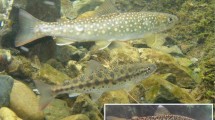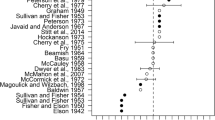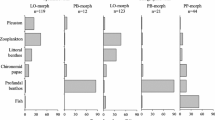Abstract
Temperature preference of juvenile (age 1+) Arctic charr (Salvelinus alpinus L.) originating from four arctic and sub-arctic populations (Svalbard and mainland northern Norway), representing a range of habitats with different temperature conditions, was studied by use of a shuttle-box system which allowed individual fish to control their environmental temperature. Based on the assumption that adaptations to long-lasting differences in thermal environments would affect temperature preference, we expected that Arctic charr from the high arctic Svalbard would prefer a lower temperature than the charr from two well-studied sub-arctic mainland lakes (i.e. one anadromous charr population from Storvatn, Hammerfest and two sympatric resident charr morphs from Fjellfrøsvatn, Målselv). There were, however, no significant differences in temperature preference among the four populations after 24 h exposure to the shuttle-box system, although the charr from the omnivore upper-water sympatric morph of Fjellfrøsvatn used significantly longer time to reach a stable thermal preferendum than the fish of the other populations. The average temperature preference at the end of the trials ranged between 10.9 and 11.6 °C among the populations. The lack of population differences suggests that temperature preference is not a polymorphic trait under strong selection in Arctic charr.

Similar content being viewed by others
References
Amundsen P-A, Knudsen R (2009) Winter ecology of Arctic charr (Salvelinus alpinus) and brown trout (Salmo trutta) in a Subarctic lake. Aquat Ecol 43:765–775
Amundsen P-A, Knudsen R, Klemetsen A (2008) Seasonal and ontogenetic variations in resource use by two sympatric Arctic charr morphs. Env Biol Fish 83:45–55
Beitinger TL, Fitzpatrick LC (1979) Physiological and ecological correlates of preferred temperature in fish. Am Zool 19:319–329
Bhat S, Amundsen P-A, Knudsen R, Gjelland KO, Fevolden S-E, Bernatchez L, Præbel K (2014) Speciation reversal in European whitefish (Coregonus lavaretus (L.)) caused by competitor invasion. PLoS One 9:e91208
Bjørnsson B, Steinarsson A, Oddgeirsson M (2001) Optimal temperature for growth and feed conversion of immature cod (Gadus morhua L.). J Mar Sci 58:29–38
Brett JR (1971) Energetic responses of salmon to temperature. A study of some thermal relations in the physiology and Freshwater ecology of sockeye salmon (O. nerka). Amer Zool 11:99–113
Coutant CC (1977) Compilation of temperature preference data. J Fish Res Board Can 34:739–745
Elliott JM, Allonby JD (2013) An experimental study of ontogenetic and seasonal changes in the temperature preferences of Unfed and fed brown trout, Salmo trutta. Freshw Biol 58:1840–1848
Elliott JM, Elliott JA (2010) Temperature requirements of Atlantic salmon Salmo salar, brown trout Salmo trutta and Arctic charr Salvelinus alpinus: predicting the effects of climate change. J Fish Biol 77:1793–1817
Eloranta A, Siwertsson A, Knudsen R, Amundsen P-A (2011) Dietary plasticity of Arctic charr (Salvelinus alpinus) facilitates coexistence with competitively superior European whitefish (Coregonus lavaretus). Ecol Freshw Fish 20:558–568
Eloranta A, Knudsen R, Amundsen P-A (2013) De-coupling of food webs associated with interspecific and intraspecific Niche segregation of Arctic charr (Salvelinus alpinus) coexisting with brown trout (Salmo trutta) in subarctic lakes. Freshw Biol 58:207–221
Fangue NA, Podrabsky JE, Crawshaw LI, Schulte PM (2009) Countergradient variation in temperature preference in populations of killifish Fundulus heteroclitus. Physiol Biochem Zool 82:776–786
Finstad FB, Anders G, Forseth T, Jonsson B, Bellier E, Hesthagen T, Jensen AJ, Hessen DO, Foldvik A (2011) Competitive exclusion along climate gradients: energy efficiency influences the distribution of two salmonid fishes. Glob Chang Biol 17:1703–1711
Fry FEJ (1947) Effects of the environment on animal activity. Univ. Toronto Stud. Biol. Ser. 55 Publs Ontario Fish Res Lab 68:1–62
Hayden B, Holopainen T, Amundsen P-A, Eloranta AP, Knudsen R, Præbel K, Kahilainen KK (2013) Ecological interactions between invading benthivores and native whitefish in Subarctic lakes. Freshw Biol 58:1234–1250
Jensen JLA, Rikardsen AH, Thorstad EB, Suhr AH, Davidsen JG, Primicerio R (2014) Water temperatures influence the marine area use of Arctic charr Salvelinus alpinus and brown trout Salmo trutta. J Fish Biol. doi:10.1111/jfb.12366
Jeppesen E, Mehner T, Winfield IJ, Kangur K, Sarvala J, Gerdeaux D, Rask M, Malmquist HJ, Holmgren K, Volta P, Romo S, Eckmann R, Sandstrom A, Blanco S, Kangur A, Stabo HR, Tarvainen M, Ventela AM, Sondergaard M, Lauridsen TL, Meerhoff M (2012) Impacts of climate warming on the long-term dynamics of key fish species in 24 European lakes. Hydrobiologia 694:1–39
Jobling M (1981) Temperature tolerance and the final preferendum—rapid methods for the assessment of optimum growth temperatures. J Fish Biol 19:439–455
Jobling M (1994) Fish bioenergetics. Chapman and Hall, London
Johnson L (1980). The Arctic charr, Salvelinus alpinus. In: Balon EK (ed) Charrs, salmonid fishes of the genus Salvelinus. The Hague, Netherlands, pp 15–92
Kellogg RL, Gift J (1983) Relationship between optimum temperatures for growth and preferred temperatures for the young of four fish species. Tran Am Fish Soc 112:424–430
Klemetsen A, Amundsen P-A, Knudsen R, Hermansen B (1997) A profundal, winter-spawning morph of Arctic charr Salvelinus alpinus (L.) in lake Fjellfrøsvatn, northern Norway. Nordic J Freshw Res 73:13–23
Klemetsen A, Elliott JM, Knudsen R, Sørensen P (2002) Evidence for genetic differences in the offspring of two sympatric morphs of Arctic charr. J Fish Biol 60:933–950
Klemetsen A, Amundsen P-A, Dempson JB, Jonsson B, Jonsson N, O’Connell MF, Mortensen E (2003a) Atlantic salmon Salmo salar L., brown trout Salmo trutta L. and Arctic charr Salvelinus alpinus (L.): a review of aspects of their life histories. Ecol Freshw Fish 12:1–59
Klemetsen A, Knudsen R, Staldvik FJ, Amundsen P-A (2003b) Habitat, diet and food assimilation of Arctic charr under the winter ice in two subarctic lakes. J Fish Biol 62:1082–1098
Klemetsen A, Knudsen R, Primicerio R, Amundsen PA (2006) Divergent, genetically based feeding behaviour of two sympatric Arctic charr, Salvelinus alpinus (L.), morphs. Ecol Freshw Fish 15:350–355
Knudsen R, Klemetsen A, Amundsen P-A, Hermansen B (2006) Incipient speciation through niche expansion an example from the Arctic charr in a subarctic lake. Proc Roy Soc B 273:2291–2298
Knudsen R, Primicerio R, Amundsen P-A, Klemetsen A (2010) Temporal stability of individual feeding specialization may promote speciation. J Anim Ecol 79:161–168
Konecki JT, Woody CA, Quinn TP (1995) Temperature preference in two populations of juvenile coho salmon, Oncorhynchus kisutch. Env Biol Fish 44:417–421
Kristensen DM, Jørgensen TR, Larsen RK, Forchhammer MC, Christoffersen KS (2006) Inter-annual growth of Arctic charr (Salvelinus alpinus, L.) in relation to climate variation. BMC Ecol 6:10–18
Lagler KF, Bardach JE, Miller RR, Passino DRM (1977) Ichthyology, 2nd edn. Wiley, New York
Larsson S (2005) Thermal preference of Arctic charr, Salvelinus alpinus, and brown trout, Salmo trutta—implications for their niche segregation. Env Biol Fish 73:89–96
Larsson S, Forseth T, Berglund I, Jensen AJ, Näslund I, Elliott JM, Jonsson B (2005) Thermal adaptation of Arctic charr: experimental studies of growth in eleven charr populations from Sweden, Norway and Britain. Freshw Biol 50:353–368
Malmquist HJ, Antonsson T, Ingvason HR, Ingimarsson F, Arnason F (2009) Salmonid fish and warming of shallow Lake Elliðavatn in Southwest Iceland. Verh Interne Verein Limnol 30:1127–1132
McCauley RW, Casselman JM (1981) The final preferendum as an index of the temperature for optimum growth in fish. In: Tiews K (ed) Proceedings of the world symposium, aquaculture in heated effluents and recirculation systems, vol 2. Heenemann, Berlin, pp 81–92
McCauley RW, Huggins NW (1979) Ontogenetic and nonthermal seasonal effects on thermal preferenda of fish. Am Zool 19:267–271
Motensen A, Ugedal O, Lund F (2007) Seasonal variation in temperature preference of Arctic charr (Salvelinus alpinus L.). J Therm Biol 32:314–320
Murdoc A, Power M (2012) The effect of lake morphometry on thermal habitat use and growth in Arctic charr populations: implications for understanding climate-change impacts. Ecol Freshw Fish 22:453–466
Ohlberger J, Mehner T, Staaks G, Hoelker F (2008a) Temperature-related physiological adaptations promote ecological divergence in a sympatric species pair of temperate freshwater fish, Coregonus spp. Func Ecol 22:501–508
Ohlberger J, Staaks G, Petzoldt T, Mehner T, Hoelker F (2008b) Physiological specialization by thermal adaptation drives ecological divergence in a sympatric fish species pair. Evol Eco Res 10:1173–1185
Ohlberger J, Brännström A, Dieckmann U (2013) Adaptive phenotypic diversification along a temperature-depth gradient. Am Nat 182:359–373
Petersen MF, Steffensen JF (2003) Preferred temperature of juvenile Atlantic cod Gadus morhua with different haemoglobin genotypes at normoxia and moderate hypoxia. J Exp Biol 206:359–364
Peterson RH, Sutterlin AM, Metcalfe JL (1979) Temperature preference of several species of Salmo and Salvelinus and some of their hybrids. J Fish Res Board Can 36:1137–1140
Power M, Dempson JB, Power G, Reist JD (2000) Environmental influences on an exploited anadromous Arctic charr stock in Labrador. J Fish Biol 57:82–98
Reynolds WW, Casterlin ME, Covert JB (1976) Behavioural fever in teleost fishes. Nature 259:41–42
Rikardsen AH, Diserud O, Elliott JM, Dempson JB, Sturlaugsson J, Jensen A (2007) The marine temperature and depth preferences of Arctic charr and sea trout, as recorded by data storage tags. Fish Ocean 16:436–447
Sandlund OT, Hesthagen T (2011) Fish diversity in Norwegian lakes: conserving species poor systems. In: Jankun M, Furgala-Selezniow WM, Wisniewska A (eds) Water biodiversity assessment and protection. Faculty of Environmental Protection and Fisheries, University of Warma and Mazury, Olsztyn, Poland, pp 7–20
Sandlund OT, Gjelland KØ, Bøhn T, Knudsen R, Amundsen P-A (2013) Contrasting population and life history responses of a young morph-pair of European whitefish to the invasion of a specialised coregonid competitor, vendace. PLoS One 8:e68156
Schurmann H, Christiansen JS (1994) Behavioral thermoregulation and swimming activity of two Arctic teleosts (subfamily Gadinae)—the polar cod (Boreogadus saida) and the navaga (Eleginus navaga). J Thermal Biol 19:207–212
Schurmann H, Steffensen JF (1992) Lethal oxygen levels at different temperatures and the preferred temperature during hypoxia of the Atlantic cod, Gadus morhua L. J Fish Biol 41:927–934
Siikavuopio SI, Knudsen R, Winger AC, Kristoffersen R (2009) Is the winter period a severe bottleneck of anadromous riverine Arctic charr parr? Ecol Freshw Fish 18:126–131
Siikavuopio SI, Knudsen R, Amundsen P-A (2010) Growth and mortality of Arctic charr and European whitefish reared at low temperatures. Hydrobiologia 650:255–263
Siikavuopio SI, Knudsen R, Amundsen P-A, Sæther B-S (2012) Effects of high temperature on the growth of European whitefish (Coregonus lavaretus L.). Aquac Res 44:8–12
Skulason S, Smith TB (1995) Resource polymorphism in vertebrates. Trends Ecol Evol 10:366–370
Skulason S, Snorrason SS, Jonsson B (1999) Sympatric morphs, populations and speciation in freshwater fish with emphasis on Arctic charr. In: Magurran AE, May RM (eds) Evolution of biological diversity. Oxford University Press, Oxford, pp 70–92
Spares AD, Stokesbury MJW, O’Dor RK, Dick TA (2013) Temperature, salinity and prey availability shape the marine migration of Arctic char, Salvelinus alpinus, in a macrotidal estuary. Mar Biol 159:1633–1646
Stol JA, Svendsen JC, Enders EC (2013) Determining the thermal preferences of Carmine Shiner (Notropis percobromus) and Lake Sturgeon (Acipenser fulvescens) using an automated shuttlebox. Can Tech Rep Fish Aquat Sci 3038
Svenning MA, Klemetsen A, Olsen T (2007) Habitat and food choice of Arctic charr in Linnevatn on Spitsbergen, Svalbard: the first year-round investigation in high Arctic lake. Ecol Freshw Fish 16:70–77
Taylor EB, Boughman JW, Groenenboom M, Sniatynski M, Schluter D, Gow JL (2006) Speciation in reverse: morphological and genetic evidence of the collapse of a three-spined stickleback (Gasterosteus aculeatus) species pair. Mol Ecol 15:343–355
Westgaard JI, Klemetsen A, Knudsen R (2004) Genetic differences between two sympatric morphs of Arctic charr Salvelinus alpinus (L.) confirmed by microsatellite DNA. J Fish Biol 65:1185–1191
Winfield IJ, Hateley J, Fletcher JM (2010) Population trends of Arctic charr (Salvelinus alpinus) in the UK: assessing the evidence for a widespread decline in response to climate change. Hydrobiologia 650:55–65
Zar JH (1996) Biostatistical analysis, 3rd edn. Prentice-Hall, Englewood Cliffs
Acknowledgments
The project has been financially supported by the Faculty of Biosciences, Fisheries and Economics, University of Tromsø and Nofima. We would also like to thank Tromsø Research Station for their technical assistance.
Author information
Authors and Affiliations
Corresponding author
Additional information
Handling Editor: Thomas Mehner.
Rights and permissions
About this article
Cite this article
Siikavuopio, S.I., Sæther, BS., Johnsen, H. et al. Temperature preference of juvenile Arctic charr originating from different thermal environments. Aquat Ecol 48, 313–320 (2014). https://doi.org/10.1007/s10452-014-9485-0
Received:
Accepted:
Published:
Issue Date:
DOI: https://doi.org/10.1007/s10452-014-9485-0




